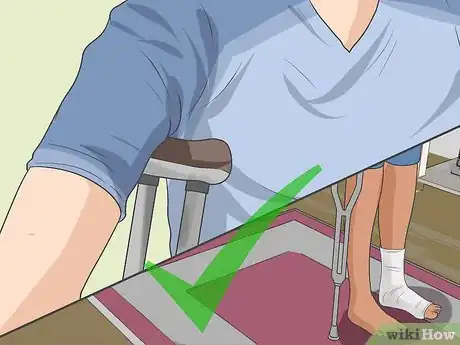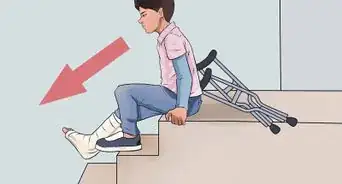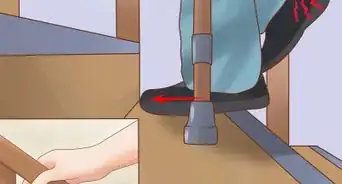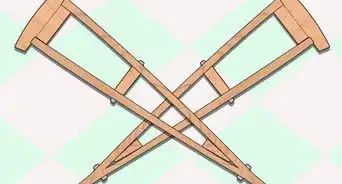This article was medically reviewed by Luba Lee, FNP-BC, MS. Luba Lee, FNP-BC is a Board-Certified Family Nurse Practitioner (FNP) and educator in Tennessee with over a decade of clinical experience. Luba has certifications in Pediatric Advanced Life Support (PALS), Emergency Medicine, Advanced Cardiac Life Support (ACLS), Team Building, and Critical Care Nursing. She received her Master of Science in Nursing (MSN) from the University of Tennessee in 2006.
wikiHow marks an article as reader-approved once it receives enough positive feedback. In this case, 95% of readers who voted found the article helpful, earning it our reader-approved status.
This article has been viewed 356,487 times.
If you injure your ankle or knee, or break a bone in your leg, your doctor will likely recommend crutches to use while you recover. Crutches are supports that allow you to keep weight off your injured leg while you stand and walk. They provide balance and enable you to perform daily activities more safely while your injury heals.[1] Switching to one crutch can be more convenient at times because it allows you to move around your environment a bit easier and have an arm free for other activities, such as carrying groceries. Using one crutch may also be easier while negotiating stairs, as long as there is a railing for support. Keep in mind that switching to a single crutch forces you to put some pressure on your injured leg and it may increase your risk of falling. As such, consult with your doctor if you prefer using a single crutch.
Steps
Walking On a Flat Surface
-
1Place the crutch under the arm opposite your injured leg. When using a single crutch, you'll have to decide which side to use it on. Medical professionals recommend placing the crutch under the arm on the side of your healthy leg — or in other words, on the opposite side of your injured leg.[2] Squeeze the crutch underneath your armpit and grab the hand grip that's roughly in the middle of the crutch.
- Putting the crutch on your uninjured side allows you to lean away from your injured side and put less weight on it. However, in order to walk with one crutch, you'll have to put some weight on the injured side with each step.
- Depending on your injury, your doctor may decide that putting weight on your injured side is not a good idea, so you may have to stick with two crutches or use a wheelchair. You should always listen to recommendations set forth by physician to ensure best rehabilitation outcome.
- Adjust the length of the crutch so at least three fingers can fit between your armpit and the padding at the top of the crutch when you are standing straight. Adjust the hand grip so that it's at wrist level while your arm is hanging straight.
-
2Position and balance the crutch properly. Once the single crutch is adjusted correctly and placed underneath the arm opposite your injured side, position it about 3-4 inches away (laterally) from the mid-point of the outside of your foot for best stability. Most, if not all, of your body weight should be supported by your hand and straightened arm because too much weight placed on your underarm can lead to soreness and potential nerve damage.[3]
- There should be padding on both the hand grip and armpit support of your crutch. Padding provides better grip and shock absorption.
- Avoid wearing bulky shirts or jackets while walking with a single crutch as it can lead to reduced movement and stability.
- If your foot or leg is in a cast or walking boot, consider wearing a thicker-heeled shoe on your healthy foot so that there's not such a height difference between your two legs. Equal leg lengths provide greater stability and reduce the risk of hip or low back pain.
Advertisement -
3Prepare to take a step. As you prepare to walk, move the solitary crutch about 12 inches forward and also step forward with your injured leg at the same time.[4] Then step past the crutch with your healthy leg while firmly grabbing the hand grip with your outstretched arm.[5] To move forward, keep repeating this same sequence: stepping with the crutch and injured leg, then stepping past the crutch with the healthy leg.
- Remember to balance yourself by keeping most of your weight on the crutch when stepping with your injured leg.
- Be cautious and take it slow when walking with a single crutch. Make sure you have firm footing and there is nothing in your path to trip you up — make sure the environment is clear of clutter and area rugs are rolled up. Allow for extra time in getting from one place to another.
- Refrain from supporting your weight with your armpit in order to prevent soreness, nerve damage and/or some sort of shoulder injury.
Walking Up and Down Stairs
-
1Determine if there is a rail. Walking up and down stairs is actually much more difficult with two crutches compared to just using one. However, you should only use a solitary crutch to navigate stairs if a stair rail or support is present.[6] Even if there is a railing, make sure it's stable and securely attached to the wall and able to support your weight.
- If there is no stair rail, then either use both crutches, take the elevator, or get assistance from someone.
- If there is a railing, you can grab it with one hand and carry one (or both) crutches in the other as you climb up the stairs — it might be easier and/or quicker without any crutches.
-
2Grab the railing with the hand on your injured side. As you start to climb the stairs, keep the crutch underneath the arm of your uninjured side and grab the railing with the hand from your injured side. Put pressure on the railing and the crutch on the opposite side at the same time and then step up with your uninjured leg first.[7] Then bring your injured leg and the crutch up beside your uninjured leg, onto the same step. Repeat this pattern until you get to the top of the stairs, but be careful and take your time.
- If possible, practice this skill with a physical therapist first.
- If there is no railing, no elevator and no one around to help you and you absolutely must climb the stairs, then try to use the wall beside the stairs for support in a similar manner that you'd use the railing.
- Allot more time for steep stairways and narrow steps, especially if you have large feet or are wearing a walking boot.
-
3Be extra cautious going down stairs. Going down stairs with two crutches or a single crutch is potentially more dangerous than going up because of the distance you can fall if you lose your balance. As such, grip the railing firmly and place your injured leg on the lower step first, followed by the crutch on the opposite side and your uninjured leg. Don't put too much pressure on your injured leg, though, because a sharp jolt of pain may make you nauseated or dizzy. Always maintain balance and don't rush yourself. Follow the pattern of injured leg, then healthy leg all the way down to the bottom of the stairs.
- Remember the pattern for walking down the stairs is opposite to that of walking up stairs.
- Take note of any objects lying on the stairs that might get in your way.
- It's always best to have someone help you down the stair if at all possible or convenient.
Warnings
- Use extra caution when walking on wet or uneven surfaces or on snowy or icy surfaces.⧼thumbs_response⧽
- Make sure your crutch is not too low beneath your armpit/arm either. It can slip out of your armpit and may cause you to lose balance or fall.⧼thumbs_response⧽
- If you are ever unsure of something, like whether or not you can safely get down some stairs, always err on the side of caution and ask for help.⧼thumbs_response⧽
References
- ↑ http://orthoinfo.aaos.org/topic.cfm?topic=a00181
- ↑ http://www.upmc.com/patients-visitors/education/rehab/Pages/walking-with-one-crutch.aspx
- ↑ http://www.upmc.com/patients-visitors/education/rehab/Pages/walking-with-one-crutch.aspx
- ↑ http://www.upmc.com/patients-visitors/education/rehab/Pages/walking-with-one-crutch.aspx
- ↑ http://www.upmc.com/patients-visitors/education/rehab/pages/walking-with-one-crutch.aspx
- ↑ http://www.bostonsportsmedicine.com/rehabilitation-protocols/crutch-walking-and-adjustment/
- ↑ http://www.bostonsportsmedicine.com/rehabilitation-protocols/crutch-walking-and-adjustment/
About This Article
To walk with one crutch, place it under the arm opposite your injured leg. Additionally, position the crutch about 3 to 4 inches away from the mid-point of the outside of your foot for the best stability. As you walk, move the crutch about 12 inches forward at the same time as you step forward with your injured leg. Then, step past the crutch with your healthy leg as you firmly grasp the hand grip. To learn how to walk up and down the stairs with one crutch, keep reading!


































































Medical Disclaimer
The content of this article is not intended to be a substitute for professional medical advice, examination, diagnosis, or treatment. You should always contact your doctor or other qualified healthcare professional before starting, changing, or stopping any kind of health treatment.
Read More...